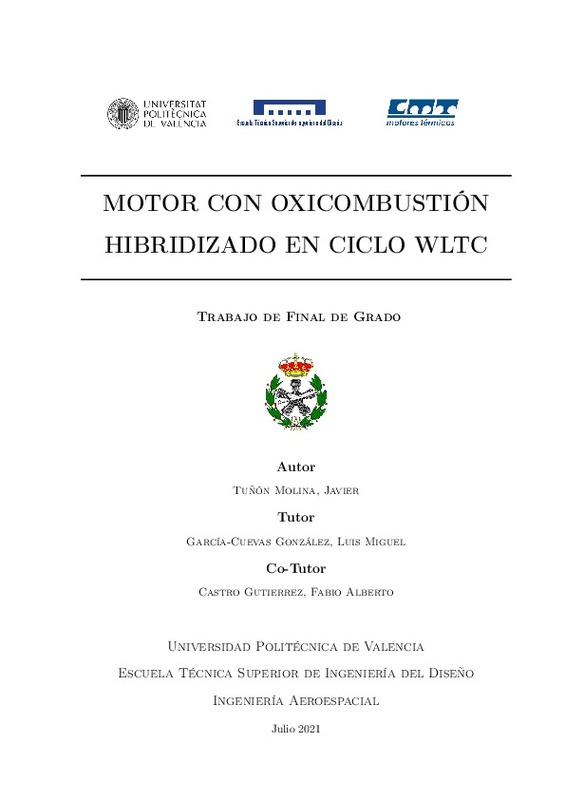JavaScript is disabled for your browser. Some features of this site may not work without it.
Buscar en RiuNet
Listar
Mi cuenta
Estadísticas
Ayuda RiuNet
Admin. UPV
Motor con oxicombustión hibridizado en ciclo WLTC
Mostrar el registro sencillo del ítem
Ficheros en el ítem
| dc.contributor.advisor | García-Cuevas González, Luis Miguel
|
es_ES |
| dc.contributor.author | Tuñón Molina, Javier
|
es_ES |
| dc.date.accessioned | 2021-09-02T10:55:02Z | |
| dc.date.available | 2021-09-02T10:55:02Z | |
| dc.date.created | 2021-07-27 | |
| dc.date.issued | 2021-09-02 | es_ES |
| dc.identifier.uri | http://hdl.handle.net/10251/171264 | |
| dc.description.abstract | [ES] Actualmente nos encontramos en una situación de emergencia climática sin precedentes, a la que los gobiernos y organizaciones internacionales están respondiendo con medidas de control y reducción de emisiones contaminantes y de efecto invernadero. El sector del transporte, y en concreto el transporte por carretera, es uno de los principales focos de generación de este tipo de emisiones, por lo que han surgido diferentes vías para atajar este problema como pueden ser la mejora del rendimiento de los motores, el uso de biocombustibles o la electrificación del transporte por carretera. En este proyecto, sin embargo, se pretende analizar la viabilidad de una nueva tecnología: la oxicombustión con producción de oxígeno in-situ y captura de CO2 combinada con la hibridación del vehículo. Esta tecnología permite realizar la combustión con un gas formado por oxígeno y EGR mediante la separación del oxígeno y el nitrógeno presente en el aire por medio de una membrana MIEC. El uso de las baterías consigue desacoplar el giro de las ruedas del funcionamiento del motor, permitiendo que este funcione continuamente en el punto de mínimo BSFC, lo que favorece el funcionamiento de la membrana y reduce el consumo de combustible. En este proyecto se analizará la viabilidad de esta tecnología mediante la simulación del ciclo de conducción WLTP con tres vehículos diferentes. Además, esta se comparará con alternativas actuales, demostrando la reducción de emisiones frente a los motores de combustión interna alternativos actuales así como la mayor autonomía frente a los vehículos eléctricos. Por último, este proyecto se enmarcará en los denominados Objetivos de Desarrollo Sostenible en los que se trabaja tanto a nivel nacional desde el gobierno de España como a nivel institucional desde la UPV. | es_ES |
| dc.description.abstract | [EN] We are currently facing a climatic emergency without precedents, to which governments and international organisations are responding with measures to control and reduce pollutant and greenhouse emissions. The transport sector, more specifically the road transport, is responsible for a huge part of the aforementioned emissions. Therefore, several measures have been developed so as to solve this problem, such as the improvement of the efficiency of the engines, the use of bio-fuels or the electrification of the vehicles. This project, however, aims to analyze the viability of a new technology: the oxycombustion with oxygen production in-situ and CO2 capture combined with the hybridization of the vehicle. This technology allows to perform the combustion process with a gas composed by oxygen and EGR thanks to the separation of the oxygen and nitrogen done by the MIEC membrane. The use of batteries helps disconnecting the wheels from the engine, allowing the latter to always work in the minimum BSFC point, which benefits the performance of the membrane and reduces the fuel consumption. In this project, the viability of this new technology will be analyzed by the simulation of the WLTP driving cycle with three different vehicles. Moreover, this technology will be compared with current alternatives, proving the reduction of emissions compared with current internal combustion engines and the increase of endurance compared with electric vehicles. Finally, this project will be related to the Sustainable Development Goals, which are defended both from a national level by the Spanish government and an institutional level by the UPV. | es_ES |
| dc.format.extent | 156 | es_ES |
| dc.language | Español | es_ES |
| dc.publisher | Universitat Politècnica de València | es_ES |
| dc.rights | Reconocimiento - No comercial - Compartir igual (by-nc-sa) | es_ES |
| dc.subject | Emisiones contaminantes | es_ES |
| dc.subject | Emisiones de efecto invernadero | es_ES |
| dc.subject | CO2 | es_ES |
| dc.subject | Combustible | es_ES |
| dc.subject | Baterías | es_ES |
| dc.subject | Híbrido | es_ES |
| dc.subject | Oxicombustión | es_ES |
| dc.subject | WLTP | es_ES |
| dc.subject | Pollutant emissions | es_ES |
| dc.subject | Greenhouse emissions | es_ES |
| dc.subject | Fuel | es_ES |
| dc.subject | Batteries: hybrid | es_ES |
| dc.subject | Oxycombustion | es_ES |
| dc.subject.classification | INGENIERIA AEROESPACIAL | es_ES |
| dc.subject.other | Grado en Ingeniería Aeroespacial-Grau en Enginyeria Aeroespacial | es_ES |
| dc.title | Motor con oxicombustión hibridizado en ciclo WLTC | es_ES |
| dc.type | Proyecto/Trabajo fin de carrera/grado | es_ES |
| dc.rights.accessRights | Abierto | es_ES |
| dc.contributor.affiliation | Universitat Politècnica de València. Departamento de Máquinas y Motores Térmicos - Departament de Màquines i Motors Tèrmics | es_ES |
| dc.contributor.affiliation | Universitat Politècnica de València. Escuela Técnica Superior de Ingeniería del Diseño - Escola Tècnica Superior d'Enginyeria del Disseny | es_ES |
| dc.description.bibliographicCitation | Tuñón Molina, J. (2021). Motor con oxicombustión hibridizado en ciclo WLTC. Universitat Politècnica de València. http://hdl.handle.net/10251/171264 | es_ES |
| dc.description.accrualMethod | TFGM | es_ES |
| dc.relation.pasarela | TFGM\145083 | es_ES |
Este ítem aparece en la(s) siguiente(s) colección(ones)
-
ETSID - Trabajos académicos [8627]
Escuela Técnica Superior de Ingeniería del Diseño






